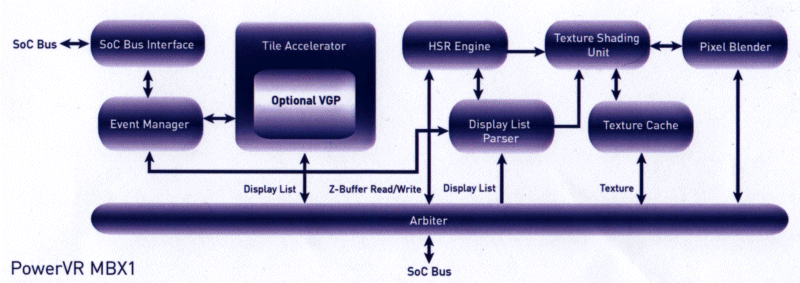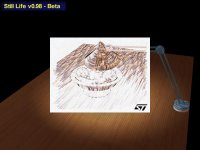PowerVR
Tucked away down the side of the AMD developers lounged were two meeting rooms that served as the PowerVR/ST Microelectronics joint ECTS presence; ST’s Joe Kreiner was on developer duties, and Img’s David Harold taking up the PR front.
PowerVR/ST were not here to show us any new products unfortunately, but they where here to highlight that the PowerVR Series 3 developers SDK has now gone public, to which David handed us a CD-Rom containing the SDK, the contents of which can also be found at the PowerVR developers site. David also showed us a number of new PowerVR demos designed to show off various effects that are capable with KYRO technology – one was a high poly count demo (in the order of 60K per frame), and others showed off various effects that can be achieved using multi-texturing, including what appeared to be ‘Non-Photorealistic Rendering’.
David was being very cagey about the release, or even expected announcement timeframes of new products, so it was very difficult to pry any information out of him in that front. Below is a Q&A session I had with David concerning a wide range of PowerVR and ST activities: Hercules appear to be pushing the KYRO pretty much now – in the press brochures at the show they have one MX and one GeForce 3 and six different versions of KYRO! I take it the sales are going pretty well?
Yeah, I believe so. ST are happy.
Obviously, right now, the PC market in general sucks. But since we weren’t selling anything a year ago everything is cheddar to us! If the PC market were in great condition then who knows what we could be doing!
With the likes of GeForce3 and Radeon 8500 NVIDIA and ATI are firmly aiming for the high end, high price market – where does PowerVR fit in?
They are knocking these things out virtually at cost, because they may as well; they’ll get their sales by trickling the technology down to the lower end. At the high end the volumes are very, very low, in the middle ground really is where your profitability is and where the true mass-market, and that’s where we are aiming our products.
…If you get OEM sales…
Yeah, at the minute we have what I would describe as second tier OEM’s; localized, but good companies – people like SystemMax and Multivision in the UK and others in Germany, France and Scandinavia. What we don’t have is a global OEM and certainly we would like one!
Little OEM’s do add up for quite a nice share of the market. In last months PC Pro magazine in the group tests, out of 10 or 11 systems KYROII based product featured in 4 or 5 of them, so we are getting a good share in the middle ground of PC’s. If you’re going to buy a PC for £2000 then you are getting a GeForce3, if you are going for a £599 PC then you are probably getting integrated graphics, if you are going in the middle then there’s a good chance you are getting a KYROII in that machine.
We are still looking for that big OEM that just keeps coming back month after month!
PowerVR handles most of the driver development for KYRO. Are you attempting to grow the development resource for this?
Yeah, we are growing driver teams, and we’re focusing on a number of different areas. Linux being one, as we’ve now got dedicated Linux resource.
But one of the biggest problems with trying to grow is that actually we’d like to employ more people that we can find. Getting people with the appropriate skill sets is very difficult.
…you should have swooped when 3dfx went under…
Yes, we do have a few 3dfx people who’ve joined us for OpenGL development.
Whats the movement on the Linux front? We’ve heard some comments on various sites about the chap who was doing it leaving, and it appeared to be in disarray after that!
I think some people are under the impression that one guy left the company and that’s it, nobody could ever developer Linux drivers for us, which is so wrong!
We are focusing on Linux development. However one of the difficulties that slows down the development is that we are focused on a number of different platforms and Linux is more important for some than others, particularly for Set-top boxes and the mobile markets. So, while we are doing PC development for Linux we need to make sure it fits in with the global development we are doing for other platforms as well.
Are the Linux drivers going to be open source or executable only?
I believe they are going to be executable only.
In some interviews you’ve given in reply to some of the negative comments other vendors have made about KYROII/PowerVR you half jokingly mentioned that you do view them as potential customers – are PowerVR actively seeking other licensees for PC products?
Errrm – we’re sitting here in ST Microelectronics booth…
I think it’s reasonable to say we are not. ST are absolutely fantastic in the PC space. I can’t imagine another company that could achieve what they have achieved in such a small amount of time. We are looking for additional customers and addition licensees, but for other platforms and devices.
Outside of MBX, how’s it going with other licenses? I.E. You’ve got the set-top box and you’ve got Dreamcast, which is trickling down now.
Dreamcast is effectively dead in the sense that there is no more being manufactured, and that SEGA, as I understand it, have hundreds of thousands of units left, not millions, so in a fairly short time there will be no more Dreamcasts available to buy. Broadly speaking we are not too unhappy about the situation because, I would guess, SEGA would have sold between 9 and 10 million units, which is more than initially we predicted they would sell of the life span of the product; clearly if they had continued to make the product longer then they could have sold even more then they could have expected. But for various reasons, most of which are to do with the fact that Sega didn’t start off with Dreamcast in a cash rich position, they haven’t been able to go on with that.
The Dreamcast technology lives on though, and Pace for example have licensed it for set-top boxes, proving what you can do with a setup box in 3D gaming. We think the set-top box is going to be a very successful market, whether it will completely eclipse consoles is difficult to say, but certainly what’s happening right now in both markets, there’s a lot of convergence going on. Consoles are becoming very un-console like; Gamecube will be the last console that is basically a box to play games with – Dreamcast had internet, Playstation 2 has DVD capabilities, and Xbox has all sort of possibilities.
The set-top box is a difficult market. In one sense there is a lot of development going on in terms of hard-drive recording and the move from analogue to digital, but the flipside is that people do no buy set-top boxes; a handful will go out and buy Sky Plus, but the majority will wait until they can get it for nothing from Sky, and that the difficult thing in this market. Luckily with 3D gaming there are a few things in its favour; one is that companies like NTL have been testing limited 2D gaming to see if people will pay for it and the answer seems to be that they will. The other advantage is that with 3D set-top boxes they aren’t relying on making the money by selling the box, they are relying on selling the games or playing them online (pay-per-play). The advantage that PowerVR has in terms of set-top boxes is that its cheap in comparison to other technologies, so you can get it in a set-top boxes without breaking the bank!
We believe that set-top boxes will be big, probably a bigger platform overall for gaming than the console market.
With regards to the Pace unit though you are going to be limited to Dreamcast specification games. Are you going to try and move the set-top box specification up?
Obviously, why Pace has done it is because they can have access to the 300 odd games available for the Dreamcast. That’s a significant advantage for the Set-Top box manufacturer since its and issue as to how to get developer to write content for a completely unproven platform; the Sega/Pace deal basically bypasses that.
However, what we are targeting for other set-top boxes isn’t necessarily the same type of features or content. We have finished a set-top box chip for ST and we are working on a core for use ARM Microprocessors for set-top boxes. So, we are approaching the market from different points to see what takes off and what happens.
Last time we talked you mentioned this set-top chip for ST. Can you tell us what type of features you’ve got in this?
Broadly its in-line with PowerVR Series 3, so we are looking at a feature set similar to KYRO.
Moving on to MBX, since the announcement over the ARM deal we haven’t heard much about it since. What’s the situation here?
We haven’t showed MBX in public yet, but we showed it at the ARM partner meeting in July, so basically all ARM’s customers, people who make PDA’s and mobile phones, have seen it working so they can get an idea of what the technology is about. We’ve also shown it at our annual general meeting, so the shareholders have seen it and we are looking for a suitable public venue, hopefully in the not too distant future, to show it off.
You’ve mentioned PDA’s and Mobiles – is that the only market you are aiming MBX at?
MBX is aimed specifically at PDA’s and 3G mobile phones; we have other cores aimed at other markets, so SCX is set-top box, CIX is car information systems – there are some similarities between these and there are some significant differences between these. Out idea at this point is to produce cores that are very specifically targeted at a certain kind of market and application so people can license them ‘off the shelf’.
Nintendo have just released Game Boy Advance, which is a pure handheld gaming device, but obviously lacking in any type of 3D abilities. To me this would seem like a perfect application for MBX even before PDA’s and Mobiles – would you be looking to get MBX into that sort of arena?
MBX would be ideally suited to that sort of device, although obviously I can’t be any more specific about the customers we are talking to, apart from saying they will be ARM customers because MBX has been designed only for use with ARM microprocessor cores. So you can go and look at the types of customers that ARM has and that’s they type of base that we are targeting with MBX.
Strangely enough the GBA is powered by an ARM processor…
I believe that’s so.
Before leaving from my meeting with David Harold I picked up a leaflet about MBX,
which had a number of interesting details on the product. Below are a few
highlights, some of which could well be ported over to future generations of PC
PowerVR products:
- Process Portable Design: .18um, .15um, .13um and beyond
- Performance optimized for UMA
- FSAA4Freeâ„¢ - Full screen anti-aliasing with no performance loss
- 2Dvia3D™ - 2D operations, including ROP’s, scaled BLT’s and colour space conversion integrated into 3D pipeline, removing requirement for separate engine
- Optional VGP (Vertex Geometry Processor) – high performance SIMD-architecture floating point coprocessor designed for optimal 3D transformation and lighting performance; capable of four floating point operations per clock
PowerVR MBX Pipeline:




